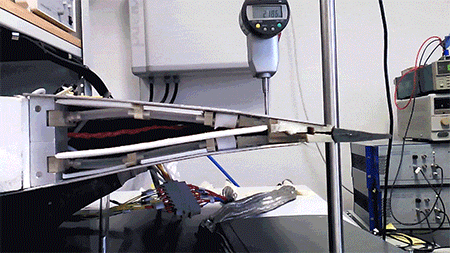A team of Toulouse-based researchers has made significant progress with morphing wings, bringing the long-sought dream of copying birds on how to achieve aerodynamics closer to reality. Successful wind-tunnel testing on a subscale wing section has convinced Airbus to proceed with full-scale flight trials in 2020.
In 2017, the European Commission (EC) began funding an intermediate three-year phase of the Smart Morphing & Sensing (SMS) project, as part of its Horizon 2020 research program. The EC’s support has facilitated construction of an almost full-scale “electroactive” wing section, for evaluation in a low-speed wind tunnel. The method being used by the Insitut de Mecanique des Fluides Toulouse (IMFT) and Laplace Laboratories to morph the wing is to combine shape-memory alloys (SMA) with piezoelectric actuators. Although electrically activated SMAs can be used to produce large displacements at low frequencies, piezoelectric actuators are suitable for high frequencies and small displacements. 
Thanks to SMAs, a high-lift flap can be made more efficient with continuous camber change, similar to a bird’s wing, as opposed to the current segmented flap design used on aircraft.
In cruise, piezoelectric actuators, located on the trailing edge, can oscillate to create a vibration. The actuators and accompanying sensors and processor form a closed-loop system. An optimum cyclical displacement, on the order of 1 mm (0.04 in.), can curb turbulence, thereby reducing drag and noise. The devices mimic the wing of a bird of prey, which uses trailing-edge feather vibration to reduce drag and noise. Early tests on the subscale wing section focused on a 30-cm (12-in.) chord flap, while the larger section now being assembled for ground testing will increase the chord to 1 m (3.3 ft.). This will make it easier to incorporate the electrically powered SMAs. It will also enable, for greater realism, the integration of a fuel system.

The technology is currently at technology readiness level (TRL) 3, meaning more research is required to prove feasibility. The key outstanding question concerns the suitability of the piezoelectric actuators for a full-scale wing. The EC-funded SMS project aims to mature the concert to TRL 5—the beginning of a demonstration—by April 2020.
Flight tests of the morphing flap on Airbus’ BLADE A340 flying testbed are scheduled to begin in May 2020.
For commercial applications, the result is hoped to be a 3-4% improvement in fuel burn. But the military are interested, too. Johannes Scheller, whose doctoral thesis detailed the two laboratories’ work on electroactive morphing, received a prize from the French armament procurement agency last month.